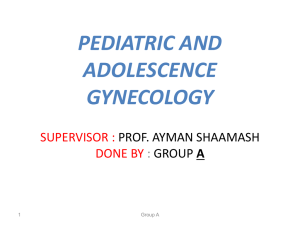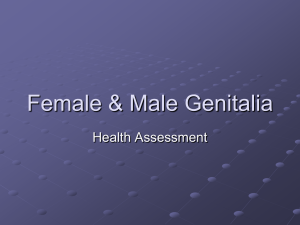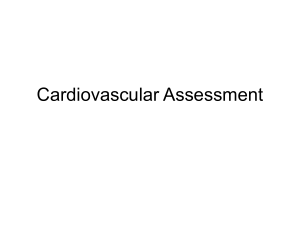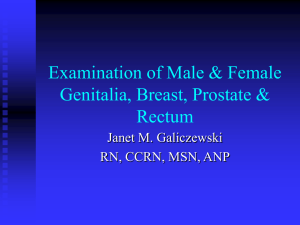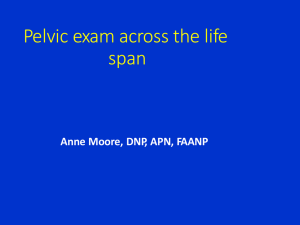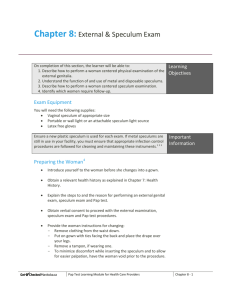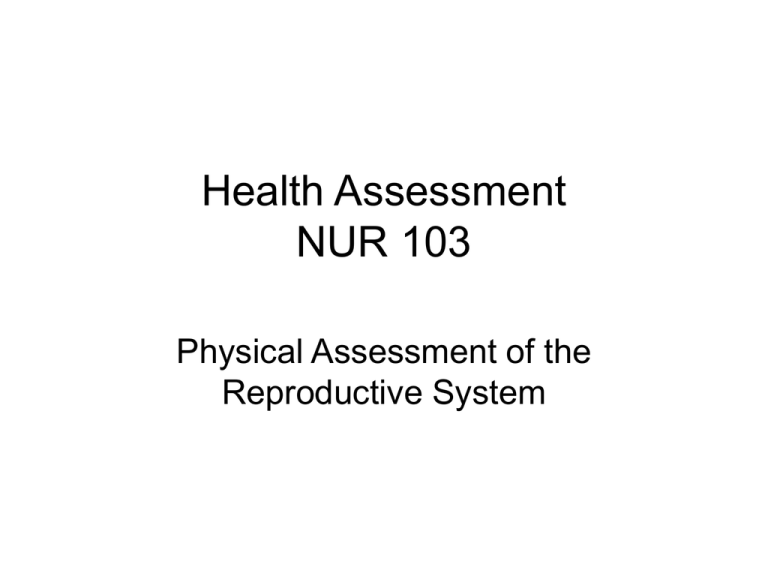
Health Assessment
NUR 103
Physical Assessment of the
Reproductive System
Objectives:
•
•
•
•
•
•
Define terminology.
Describe anatomy and physiology.
Identify equipment.
Identify positioning.
Identify techniques.
Explain process of performing assessment of
male and female reproductive systems.
• Recognize normal and abnormal data.
• Differentiate between normal and abnormal
assessment data.
Terminology
The External Female Genitalia
• Vulva- (or pudendum) The external genitalia.
• Mons pubis- A round, firm pad of adipose tissue covering the
symphysis pubis.
• Labia majora- Two rounded folds of adipose tissue extending from
the mons pubis down and around to the perineum.
• Labia minora- Two smaller, darker folds of skin inside the labia
majora.
• Frenulum- A transverse fold which joins the labia minora poseriorly.
• Clitoris- A small, pea –shaped erectile body, homologous with the
male penis and highly sensitive to tactile stimulation.
• The labial structures encircle a boat-shaped space termed the
Vestible.
• Urethral meatus- A dimple 2.5 cm posterior opening posterior to the
clitoris.
•
•
•
•
•
•
•
•
•
Terminology
The Internal Female Genitalia
Vagina- A flattened, tubular canal extending from the orifice up and
backward into the pelvis. Leads into the female reproductive tract.
Rugae- Thick transverse folds which enable the vagina to dilate widely
during childbirth.
Cervix- A smooth doughnut-shaped area with a small circular hole or os,
found at the end of the canal that leads into the uterus.
Anterior fornix- A continuous recess, present in front of the cervix.
Posterior fornix- Continuous recess found in back of cervix.
Rectouterine pouch, or cul-de-sac of Douglas- Found behind the
posterior fornix, a deep recess, formed by the peritoneum, dips down
between the rectum and cervix.
Uterus- A pear-shaped, thick walled, muscular organ which a fetus
develops. Flattened anteroposteriorly, measuring 5.5 to 8 cm by 3.5-4 cm
wide, and 2-2.5 cm thick.
Fallopian tubes- Two pliable, trumpet-shaped tubes, 10 cm long, extending
from the uterine fundus laterally to the brim of the pelvis. Transports an egg
cell from the region of the ovary to the uterus.
Ovaries- The primary reproductive organ of the female; An egg-cell
producing organ which is oval shaped, 3 cm long by 2 cm wide.
Equipment
For Female Examination
• Gloves
• Protective clothing
• Vaginal Speculum
Of appropriate size
• Large cotton-tipped applicators
(rectal swabs)
Pederson Speculum
• Materials for cytologic study:
• Glass slide with frosted end
• Sterile Cytobrush or cottontipped applicator
• Ayre’s spatula
• Spray fixative
• Specimen container for
gonorrhea Cx/chlamidia
• Small bottle of normal saline,
potassium hydroxide, and
acetic acid (white vinagar)
• Lubricant
Positioning for
Female Examination
1. Begin with woman in sitting position to
establish equal status and trust.
2. Place woman in lithotomy position, with
the examiner sitting on a stool.
3. Help the woman into position, feet
in stirrups, knees apart, and buttocks
at edge of examination table.
4. Arms should be at the woman’s sides,
not across chest or over the head.
5. Drape the woman fully, covering the stomach,
and legs, exposing only the vulva to your
view.
Techniques
• Have woman empty
bladder.
• Position the exam table
so her perineum is not
exposed to inadvertent
open door.
• Ask if she would like a
friend, family member
present.
• Elevate her head and
shoulders to a semisitting position to maintain
eye contact
• Place stirrups so the legs
are not abducted too far.
• Explain each step in the
exam before you do it.
• Assure the woman she
can stop the exam at any
point she should feel
uncomfortable.
• Use a gentle, firm, touch,
and gradual movements.
• Communicate throughout
the exam. Maintain
dialogue to share
information.
Assessment of the
Female Genitalia
Normal Findings:
Inspection:
Note:
•Hair distribution- usual pattern
•Skin color, no lesions
of inverted triangle.
•Labia Majora symmetric, plump,
and well formed. Nulliparous woman,
labia meet in midline; following
vaginal delivery, labia are gaping and
slightly shriveled.
Abnormal Findings:
Inspection:
Note:
•Refer any suspicious lesion for biopsy
•Consider delayed puberty if no pubic
hair or breast development has occurred
by age of 13.
Nits, or lice at base of pubic hair
•Swelling
Normal Findings:
• No lesions, except for
occ. Sebaceous cysts.
(with gloved hand separate labia majora to inspect).
• Clitoris
• Labia minora- dark pink, and
moist, usually symmetric.
• Urethral opening appears
stellate or slitlike, midline.
• Vaginal opening (introits) may
appear as narrow, vertical slit
or as a larger opening.
• Perineum-smooth. A wellhealed episiotomy scar,
midline or mediolateral
following vaginal birth.
• Anus- course skin of increased
pigmentation.
Abnormal findings:
• Excoriation, nodules,
rash, or lesions.
• Inflammation or lesions.
• Polyp
• Foul-smelling, irritating
discharge.
Palpation:
Abnormal Findings:
•
•
•
•
Normal Findings:
Assess the urethra &
Skene’s glands with gloved finger.
Asses vagina, gently milk the
urethra by applying pressure up
and out.
Assess Bartholin’s glands, post.
Of labia majora with index finger
inside and thumb outside.
Should feel soft and homogeneous.
Assess pelvic musc. by
1. Palpate perineum, should feel
thick, smooth, and musc. In
nulliparous, thin and rigid in multiparous.
2. Ask woman to squeeze vaginal
opening around fingers, should
feel tight in nulliparous.
3. Separate the vaginal orifice and
ask pt. to strain down. No bulging
of vaginal walls or urinary
incontinence.
•
Tenderness
•
Induration along urethra, pain,
urethral discharge
•
Swelling, induration, pain with
palpation, erythema around or
discharge from duct opening
•
Tenderness, paper thin perineum,
absent or decreased tone may
diminish sexual satisfaction.
•
Bulging of vaginal walls indicates
cystocele, rectocele, or uterine
prolapses.
Urinary incontincence
•
Internal Genitalia
• Speculum
Examination:
Select proper-sized
speculum
Grave’s Speculum
Pederson Speculum
Speculum Examination
• Warm and lubricate speculum under warm
running water.
• Avoid gel lubricant – bacteriostatic, distorts cell
in cytology specimen collected.
• Insert by asking woman to bear down. Relaxes
perineal muscles and opens introitus.
• Insert speculum at 45-degree angle downward
toward the small of woman’s back.
• After blades are fully inserted, open them by
squeezing handles together.
• Cervix should be in full view.
• Try closing blades by tightening the thumbscrew.
Inspect the cervix and its os
Normal Findings:
• Color: normally pink,even;
2nd month preg. Blue
(Chadwick’s sign); past
menopause-pale.
• Position: midline,anterior or
post. Projects 1-3 cm into
vagina.
• Size: Diameter-2.5 cm (1”).
• OS: Small, round in
nulliparous, horizontal irreg.
slit, may show healed
laceration on sides.
Abnormal Findings:
• Redness, inflammation
• Pallor wit anemia, cyanotic
other than with pregnancy.
• Lateral position- adhesion or
tumor. Projection >3 cm may
be prolapse.
• Hypertrophy > 4 cm occurs
with inflammation or tumor.
• Surface: Smooth,
• Surface reddened,
eversion, or ectropion,
granular, asymmetric,
past vaginal delivery;
around os.
Endocervial canal everted • Friable, bleeds easily.
or rolled out. Red, beefy • Any lesions: white patch
halo inside the pink
on cervix, strawberry
cervix surrounding os.
spot.
• Refer any suspicious,
red, white, or pigmented
lesion for biopsy.
Inspect the Vaginal Wall
Normal Findings:
• As you remove the
speculum, inspect
vaginal wall. Pink,
deeply rugated, moist,
smooth, normal
discharge thin, clear,
opaque, stringy,
odorless.
Abnormal Findings:
• Inflammation, lesions.
• Leukoplakia, appears as
spot of dried paint.
• Vaginal discharge: thick,
white, curdlike with
candidiasis, profuse,
watery, gray-green, frothy
with trich.; or gray, greenyellow, white, or foul
odorous discharge.
Bimanual Exam
Bimanual Exam
Technique of exam:
1.Lithotomy position,
2.lubricate fingers of gloved hand.
3. Insert fingers into vagina posteriorly.
4. Use both hands to palpate internal genitalia to
assess location, size, & mobility, screen for
tenderness or mass.
5. One hand is on the abdomen, the other into the
vagina.
6. Palpate the vaginal wall. Should feel smooth, no
area of induration or tenderness.
7. Locate cervix in midline. Palpate using palmar
surface of fingers. Note consistancy.
Normal findings of cervix:
• Consistency: smooth,
firm, tip of nose.
Softens, feels velvety at
5-6 wks gest. (Goodell’s
sign).
• Contour: Evenly
rounded.
• Mobility: With finger on
either side, move cervix
gently from side to side.
No pain.
Abnormal findings of
cervix:
• Nodule, Tenderness.
• Hard with malignancy,
Nodular, Irregular,
Immobile with
malignancy.
Palpation of pelvic organs:
1. Palpate Uterus with
intravaginal fingers in ant.
fornix. Palpate with
abdom. Hand midway
between umb. And
sympthysis.
2. Palpate uterine wall with
fingers in fornices, firm,
smooth, with contour of
fundus rounded, freely
movable, nontender.
3. Palpate Adnexa on lower
quadrant inside ant. Illiac
spine with intravaginal
fingers in lateral fornix.
May not be palpable.
Abnormal findings:
Painful with inflammation or
ectopic pregnancy.
• Enlarged uterus, lateral
displacement, nodular
mass, irregular, asymmetric
uterus, fixed, immobile,
tenderness.
• Enlarged adnexa, nodules
or mass. Immobile, marked
tenderness, pulsation,
palpable fallopian tube.
Retrovaginal Exam
Technique:
1. Use this tech. when assessing rectovaginal septum, post.
Uterine wall, cul-de-sac, and rectum.
2. Change gloves- avoids spreading poss. Infection.
3. Lubricate first two fingers.
4. Instruct pt. poss. Feeling of discomfort.
5. Ask pt. to bear down as fingers are inserted into vagina,
middle finger is gently inserted into rectum, while pushing
with abdominal hand.
6. Note: Rectovaginal spetum-smooth, thin, firm, pliable.
7. Rectovaginal pouch, or cul-de-sac- not palpated.
8. Uterine wall and fundus feel firm, smooh.
9. Rotate intrarectal finger to check rectal wall and anal
sphincter tone.
10. Give pt. tissue to wipe area, help her up. Remind her to
slide hips back from edge before sitting up.
Abnormal Findings of External
Genitalia
• Pediculosis Pubis
(Crab Lice):
Severe perineal itching,
excoriations,
erythematous areas.
May see little dark
spots, nits (eggs)
adherent to pubic hair
near roots.
Syphilitic Chancre
•Begins as small, solitary
silvery papule, erodes to red,
round
or oval, superficial ulcer with
yellowish serous discharge.
Palpation- nontender
indurated base; can be lifted
like button
between thumb and finger.
Herpes Simplex Virus- Type 2
• Episodes of local pain,
dysuria, fever.
• Clusters of small, shallow
vesicles with surrounding
erythema, erupt on genital
areas, inner thigh.
Vesicles on labia rupture in
1-7 days, leaving painful
ulcurs.
Initial infection lasts 7-10 days.
Virus remains dormant
indefinitely;
recurrent infections last 3-10
days
with milder symptoms.
Red Rash- Contact Dermatitis
•History of skin contact with
allergenic
substance in environment, intense
pruritus.
•Primary lesion- red, swollen,
vesicles.
•May have weeping of lesions,
crusts,
scales, thickening of skin,
excoriations
from scratching. May result from
reaction
to feminine hygiene spray, synthetic
underclothing.
Genital Human Papillomavirus
(HPV, Condylomata Acuminata,
Genital Warts
•Painless warty growths, may
•Be unnoticed by woman.
•Pink or flesh-colored, soft,
pointed, moist, warty papules.
•Single or multiple in cauliflowerlike patch. Occur around
vulva, introitus, anus, vagina,
cervix.
Terminology related to assessment of male reproductive
systems
:
• Penis: External reproductive organ of the male
through which the urethra passes. Composed of
three cylindrical columns of erectile tissue: two
corpora cavernosa on dorsal side, one corpus
spongiosum ventrally.
• Glans: (Corpus spongiosum) Cone of erectile
tissue, found at the distal end of shaft.
• Urethra: Tube leading from urinary bladder to
outside of body, transverses the corpus spong.,
and its meatus forms a slit at the glans tip.
• Frenulum: A fold of forskin extending from
urethral meatus ventrally.
• Scrotum: A loose, protective sac, encloses
testes.
• Epididymis: Highly coiled tubule that leads from
the seminiferous tubules of the testis to the vas
deferens. Main storage site of sperm.
• Vas Deferns: A muscular duct or tube that leads
from the epididymis to the urethra of the male
reproductive tract.
• Spermatic cord: Ascends along the posterior
border of the testes and runs through the tunnel
of the inguinal canal into the abdomen.
• Ejaculatory duct: A duct of the seminal vesicle
behind the bladder which empties into the
urethra.
• Lymphatics: Where the penis and scrotal surface
drain into the inguinal lymph nodes, those of
testes drain into the abdomen.
Examination Equipment Needed for
Male Anatomy:
• Gloves- Wear gloves
during every male
genitalia exam.
• Occasionally: glass
slide for urethral
specimen
• Materials for cytology
• Flashlight
Positioning for Male Examination:
1. Position male standing with undershorts
down, with appropriate draping.
2. Examiner should be sitting. (Male may
be supine for first part of exam, standing
for hernia check.
3. Take time for pt. to discuss genitourinary
history.
Inspection and palpation of male
reproductive system:
Normal Findings:
• Penis: skin wrinkled, hairless, no
lesions.
Abnormal Findings:
• Inflammation, solitary ulcer, grouped
vesicles, superficial ulcers, wartlike
papules.
•
•
Glans: smooth, no lesions. Retract
uncircumcised forskin. Cheesy
smegma uncer foreskin may be
noted.
Always slide foreskin back to original
position.
•
•
•
•
•
•
•
•
Inflammation, lesions on glans or
corona.
Phimosis- unable to retract foreskin.
Paraphimosis- unable to return
forskin to original pos.
Hypospadias- ventral location of
meatus.
Epispadias- dorsal location of meatus
Pubic lice or nits- excoriated skin
Stricture- narrowed opening
Edges that are red, everted,
edematous, purulent discharge
(urethritis).
Nodule, induration, tenderness
Inspection and palpation of scrotum
Normal Findings:
1. Inspect scrotum as male holds
penis.
2. Scrotal size varies with room
temp.
3. Should be asymmetrical with left
scrotal half lower than right.
4. Spread rugae out between
fingers, Inspect post. surface.
5. Palpate gently ea. Half between
thumb and first two fingers.
Contents should easily slide.
Testes palpable, oval, firm,
rubbery, smooth, equal bilat.
Freely movable.
6. Epididymis feels discrete, softer
than testis, smooth, nontender
Abnormal Findings:
• Scrotal swelling (edema)
taut and pitting. (Heart failure, renal
failure, local inflammation. Lesions
• Inflammation
• Absent testes, temporary
migration, true cryptorchidism
• Atrophied testes-small, soft
• Fixed testes
• Nodules on testes or epididymides
• Marked tenderness
• Indurated, swollen, tender
epididymis (epididymitis)
• Inspect each spermatic cord
between thumb and forefinger,
along its length from epidiymis
to external inguinal ring.
Should feel smooth, nontender
cord.
• Any mass? Note tenderness,
distal or proximal to testes, can
you place finger over it?, does
it reduce when pt. lies down,
can you auscultate bowel
sounds over it.
• Transillumination: Perform this
maneuver if you note swelling
or mass. Darken room, shine
flashlight from behind scrotal
contents, normal scrotal
contents do not illuminate.
• Abnormal findings:
• Thickened cord, soft, swollen,
tortuous.
• Abnormalities in scrotum:
hernia, tumor, orchitis,
epididymitis, hydrocele,
spermaatocele, varicocele.
• Serous fluid does trasilluinate
and shows red glow, e.g.,
hydrocele, or spermatocele.
Solid tissue and blood do not
transilluminate, e.g., hernia,
epidiymitiis, or tumor.
Inspect for hernia
Normal Findings:
Technique1. Inspect inquinal region for bulge as pt.
stands and strains.
Normally, none is present.
2.Palpate right side of inquinal canal by
asking pt. to shift wt. onto left leg.
Place right index finger low in the right
scrotal half. Palpate up length of
spermatic cord, invaginating scrotal
skin as you go, to external inguinal
ring. Feels like triangular slitlike
opening, may go easier if you ask pt.
to bear down.
Normally, there is no change. Repeat
procedure to left side.
3. Palpate inguinal lymph nodes by
palpating horizontal chain along groin
inferior to ligament and vertical chain
along inner thigh. Normal- feels small,
soft, discrete, and movable.
Abnormal Findings:
• Bulge at external inguinal ring or
femoral canal (hernia may be present
but easily reduced and may appear
only intermittently with increase in
intraabdominal pressure.)
• Palpable herniating mass bumps your
fingertip or pushes against the side of
your finger.
•
Enlarged, hard, matted, fixed nodes.
Always encourage self care
by:
Teaching every male from 13-14 years
old through adulthood to perform
testicular self-examination (TSE).


